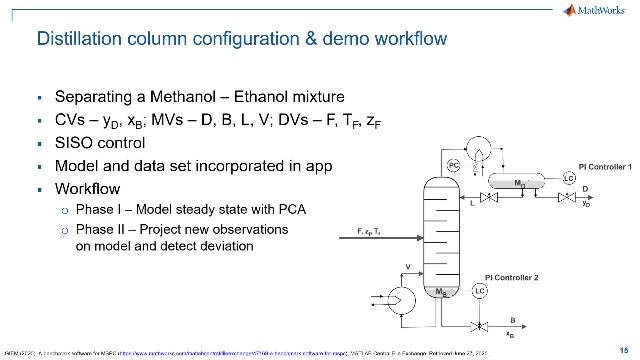Multivariate Analysis for Process Monitoring | Fault Detection and Diagnosis in Chemical and Petrochemical Processes, Part 1
From the series: Fault Detection and Diagnosis in Chemical and Petrochemical Processes
The process industries use big data for not only predictive purposes but also to extract relationships for optimizing a process. Key to big data analysis are multivariate analysis techniques such as principle component analysis (PCA). This is uniquely suited for the analysis and interpretation of process data because it exploits the correlations amongst variables in the data sets. Learn about the applications of multivariate analysis and industrial success stories with MATLAB®.
Published: 21 Jan 2021
Hi. I'm Samvith Rao. In this video series, we will look at fault detection and diagnosis in process and chemical plants. Specifically, I will talk about multivariate analysis techniques, like VCA, walk through a MATLAB demo on fault detection and diagnosis, and also, we will look at multiple industrial success stories in this application.
Before we delve into this topic, it helps to take a step back. Traditionally, chemical engineers have relied on process simulations and first principles modeling to understand the processes. Of late, the advent of large amounts of processed data has given rise to techniques in data-driven modeling. These help obtain actionable insights from process data and aid in simulations and engineering studies, such as debottlenecking, increasing model quality and increasing production. Today, we will touch on a part of those analytics technologies.
All right. So what does advance data analytics exactly mean in this industry? This is the way to help summarize my view of these analytics in this space. Analysis on the first column, the first two conventional analysis tools, things that the industry has been doing for quite some time. Even if they don't put it in the practice, they're certainly aware of it to a greater extent than machine learning analytics. this is all the current rage right now.
Big data-- the first two data that satisfies the previous criteria of volume, velocity, and variety. This could be process data, text logs, image data, and so on. Data, in this industry, refers to conventional time series data. This industry generates a huge ton of data. But it is mostly used for making reports, other than forward-looking analysis, something that I was guilty in my previous job, as well.
Each of the squares indicates MathWorks value proposition in the space industries. You can use MATLAB for automating those data analytics, performing multivariate analysis on big data, predictive maintenance by using machine learning, and fault detection and image processing using machine learning and big data. In this presentation today, we will only be looking at multivariate analysis.
First, the data are often characterized by the presence of large numbers of variables from different sources, something that is generally much more difficult to handle than just large numbers of observations. How do I determine what are the principal variables I need to be looking at? What is it affect on the process? And how I control these variables so I can consistently achieve a high quality and keep costs low. Latent variable methods, like principal component analysis and projection to latent structures are uniquely suited for the analysis and interpretation of process data, because these are methods that explore the correlations amongst variables in the data search.
Because these methods tell you exactly what variables you can take very specific action, such as avoid unplanned downtime, improved plant performance through cycle time reduction, reduce waste, root cause investigation of defective batches, and controlling product quality. There have been several success stories using these techniques in the industry. Here, I have highlighted a few of them.
The first story talks about a batch process for drying an agrochemical material at FMC Corp, a fertilizer company. They used custom MATLAB toolboxes and analyzed the process and isolated the process variables that were responsible for the product quality differences. The second paper is from Pfizer. And the objective was to determine the materials available in inventory that should be combined, and the ratios of those that should be blended in order to obtain the best next lot of finished product.
In this project at Frito-lay, an on-line vibrational center was used to develop a soft center for real-time prediction of product texture in chips. An accelerometer is used to record the vibrations generated by chips falling on to a metal surface. The blister level and brittleness of the chips are predicted by analyzing the various sensor data together using TLS.
Another example is from GSK. They spoke at MATLAB Expo 2019. Of the products is Sensodyne, which is a toothpaste. Toothpaste is almost regulated like medicine in some countries. So there is a lot of regulation and quality check, of course. Change and experimentation is quite difficult in the process.
You can see some of the challenges they face, here. Batch process quality depends on the experience of the operator. Databases are silos. You need different log ons, et cetera. In this presentation, they spoke about how they used their process data to improve the performance of future batches.
If you remember the 2 by 2 framework from the earlier slides, you can see it as well, duplicated here. They used univariate statistics, multivariate analysis, and machine learning to get knowledgeable insights from their data.
And finally, they also spoke about why they chose MATLAB. You can see multiple different reasons mentioned here, linking different files, rapid prototyping, consulting support on projects, and app building.







